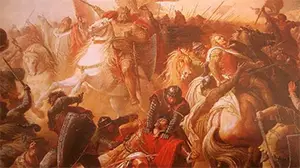Otto the Great: German King, Holy Roman Emperor
Otto the Great was the most powerful figure in Europe in the first half of the 10th Century. His reign extended from Duke of Saxony to King of East Francia and then to Holy Roman Emperor. He ruled over a vast amount of territory. He was born on Nov. 23, 912, in East Francia. His father was Henry the Fowler, who was then Duke of Saxony. His mother was Matilda of Ringelheim. When Otto was 3, his father rebelled against the King of East Francia, Conrad. That rebellion was unsuccessful, but through it Henry emerged as a strong candidate to be the next king. Conrad was the first ruler of East Francia to have been elected by the nobles; when he died, in 915, the nobles again selected their ruler, and they chose Henry the Fowler. Henry provided a strong hand at the helm as East Francia held off repeated threats from the Danes, Magyars, and Slavs. Of particular effectiveness was a system of fortifications that Henry ordered built. As well, Henry's embrace of heavy cavalry proved the difference-maker at the Battle of Riade, a 933 route of the Magyars. Otto, too, gained military experience, turning back invasions from the Slavs in 929. When Henry died, in 936, his son became King Otto I. Otto had married Ædgyth of England, the daughter of the king, Edward the Elder), in 930. They had two children, both of whom survived into adulthood: Liudolf (930) and Liutgarde (932). 
As king, Otto set about consolidating his rule. Eberhard, the new Duke of Bavaria, did not recognize Otto's right to rule, despite his being the son of the preceding king; Otto took an army into Bavaria and conquered it. The neighboring Franks tried to interfere, making an alliance with Otto's half-brother, Thankmar, and with a handful of other recalcitrant nobles; at the same time, Otto's younger brother, Henry, made his own attempt to revolt. Otto put down all challenges and tried to prevent new ones by appointing family members as dukes. Otto's wife, Ædgyth, died in 946. He was unattached when he led an army into northern Italy, to intervene in a succession dispute there. King Lothair II of Italy had died, leaving his wife, Adelaide, as nominal heir to the throne. A teenager herself, she had had one child already, a daughter, Emma, who married France's King Lothair. In the meantime, Berengar of Ivrea had seized the Italian throne and tried to force Adelaide to marry his son, Adalbert. The widowed queen refused and fled. She appealed to Otto for protection, and he obliged, arriving in 951 and marrying her himself. Also at this time, Otto claimed the throne of the Lombards. 
Otto's son, Liudolf, wanted his own share of power and led a revolt against his father, in 953. An invasion of Magyars in 954 convinced Liudolf to give up his rebellion, and Otto's forces won the Battle of Lechfeld, in 955, ending the Magyar threat for good. Berengar had earlier agreed to pay homage to Otto. That respect disappeared when Berengar attacked the Papal States. In desperation, Pope John XII asked Otto for help. Otto's condition was that he be crowned Holy Roman Emperor. The pope agreed, and Otto led an army into Italy. Otto and his second wife, Adelaide, had had four children, two of whom survived into adulthood: Matilda and Otto. When the king marched into Italy, he left behind his young son as heir apparent. 
Berengar withdrew as Otto advanced. Otto marched to Rome and received the Holy Roman Empire crown, on Feb. 3, 962. He then went after Berengar. Otto gained his opponent's surrender in 963 and declared himself master of Italy. The pope, fearing that Otto would renege on his promise to leave the Papal States alone, appealed to Berengar's son, Adalbert, to find allies and attack Otto. The emperor found out about the plan, marched on Rome, and deposed the pope, naming a new one, Leo VIII. Confident in his rule, Otto sent most of his troops home to Germany. The Roman populace didn't like Otto's choice of pope and forced him to leave, putting John XII back in charge. Otto recalled his army, marched again on Rome, and again saw Leo VIII as pope. He then went with his army back home. Again a rebellion arose, led by Adalbert. Otto sent a trusted lieutenant, Burchard III of Swabia, at the head of an army into Italy. At the Battle of the Po, in 966, Burchard was successful. The year before, Pope Leo VIII had died and Otto had approved the naming of a new pope, John XIII. Again the people grew disenchanted and drove out the pope, and again Otto marched into Italy at the head of an army. The emperor succeeded again, rounding up the leaders of the rebellion and having them executed while also restoring John XIII to the papacy. Otto then made Rome his home. Seeking to further his influence, Otto made a series of negotiations with the Byzantine Empire, including the marriage of Otto II, crowned as co-emperor in 967, to Theophanu, the niece of Byzantine Emperor John I Tzimiskes, in 972. Otto returned to Germany. He was the most powerful man in Europe. In the spring of 973, he became seriously ill. He died on May 7, and his son, then 17, succeeded him as Emperor Otto II. |
|
Social Studies for Kids
copyright 2002–2024
David White




